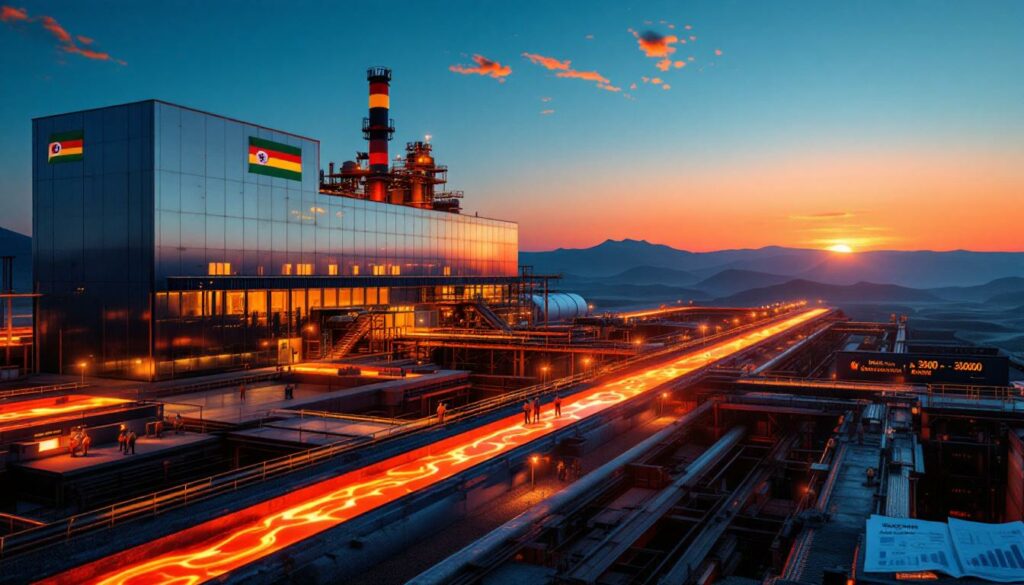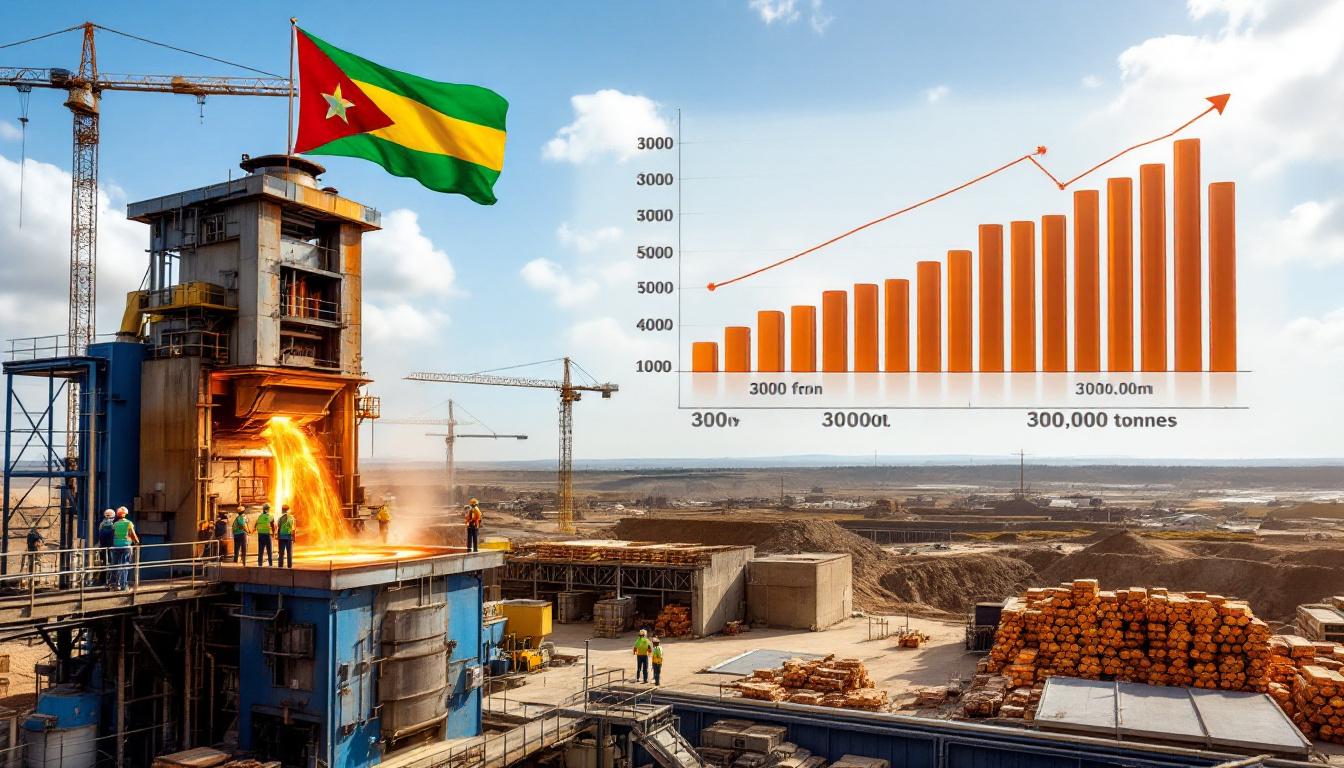Revitalizing Zambia's Copper Industry: Konkola's Smelter Transformation
Konkola Copper Mines (KCM), the Zambian subsidiary of Vedanta Resources, has embarked on an ambitious journey to overhaul its copper smelting facility. This comprehensive renovation represents a pivotal move in Zambia's copper industry, addressing critical infrastructure needs while positioning the company to meet its bold production goals following Vedanta's return to management control in mid-2024.
The smelter revamp comes at a crucial time for Zambia's copper sector, as the country seeks to strengthen its position as Africa's second-largest copper producer. The renovation addresses fundamental constraints that have limited domestic processing capacity and forced the country to waive export taxes on substantial volumes of copper concentrates.
The Strategic Importance of the Smelter Renovation
The announced refurbishment targets two essential challenges that have hampered KCM's operations:
- Structural integrity restoration of aging equipment that has deteriorated over years of limited maintenance
- Operational efficiency enhancements designed to support the dramatic production volume increases outlined in Vedanta's strategic plan
According to KCM's statement, the renovation will require a "full shutdown and refurbishment" to properly address these fundamental issues. This comprehensive approach underscores the severity of the current limitations and the company's commitment to a thorough solution rather than incremental fixes.
Investment Commitments and Financial Framework
Vedanta's financial commitment to revitalizing its Zambian copper operations is substantial:
- $1.2+ billion pledged for five-year operational upgrades across all KCM facilities
- $400 million already invested since regaining control in mid-2024
- $250 million specifically allocated to creditor settlements
- $124 million installment payment already completed
- Additional funding (specific amount undisclosed) earmarked for the smelter renovation
This significant capital injection demonstrates Vedanta's long-term commitment to its Zambian operations and provides the financial foundation necessary for the ambitious production growth targets the company has established.
How does this fit into Vedanta's production targets?
Vedanta has outlined extraordinarily ambitious production goals for KCM, requiring a transformation of operations across mining, processing, and smelting capacities. The scale of this transformation becomes evident when examining the current production levels against future targets.
Current Production vs. Future Goals
KCM's production trajectory reveals the magnitude of the challenge ahead:
- 2024 production: Below 30,000 tons (less than 10% of target)
- 2030 production target: 300,000 tons annually
- Required increase: Over 900% growth in just six years
This production leap represents one of the most ambitious scaling plans in the global copper industry. For context, KCM's historical production peaked at approximately 200,000+ tons annually before the ownership dispute erupted in 2019, suggesting that while ambitious, the target builds on previously demonstrated capabilities.
Konkola Deep Mining Project
A substantial portion of Vedanta's capital expenditure is directed toward the Konkola Deep mining project, which serves as the cornerstone of KCM's production growth strategy:
- Designed to access deeper, higher-grade copper reserves beneath existing operations
- Requires specialized equipment and techniques to manage increased depths
- Delivers access to ore bodies essential for meeting long-term production targets
- Complemented by the smelter refurbishment to ensure processing capacity matches mining output
Without the parallel development of the Konkola Deep project and the smelter renovation, KCM would face a misalignment between mining capacity and processing capabilities, creating bottlenecks that would undermine production goals.
Why is the smelter renovation critical for Zambia's copper industry?
The significance of KCM's smelter renovation extends far beyond the company itself, addressing fundamental constraints within Zambia's broader copper industry infrastructure.
Current Operational Constraints
Zambia's copper sector currently faces several interconnected challenges that the smelter renovation directly addresses:
- Processing bottlenecks created by inefficient and aging smelter technology
- Limited domestic processing capacity forcing the export of unprocessed concentrates
- Technical challenges preventing full utilization of locally produced copper concentrates
- Value chain limitations that reduce revenue potential from copper resources
These constraints have created a situation where despite having significant mineral resources, Zambia has been unable to capture the full economic value of its copper endowment.
National Economic Implications
The smelter renovation has significant implications for Zambia's national economy:
- As Africa's second-largest copper producer, processing constraints directly impact national export revenues
- The government recently approved a tax waiver for 255,000 tons of copper concentrates specifically because KCM's smelter cannot process the material
- These processing limitations affect not just KCM but the entire national copper output and revenue potential
- Improved smelting capacity would reduce reliance on external processing, enhancing value retention within Zambia
The export tax waiver highlights how critical the smelter renovation is to national economic interests, with the government willing to forego immediate tax revenue to address the processing capacity shortfall.
What challenges must Vedanta overcome to meet its targets?
Despite the substantial investment and clear strategic direction, Vedanta faces significant hurdles in executing its ambitious plan for KCM.
Operational Hurdles
The path to achieving the 300,000-ton production target is fraught with complex challenges:
- Aging infrastructure requiring significant capital investment beyond just the smelter
- Technical complexity of renovating metallurgical facilities while minimizing operational disruption
- Production interruptions during the renovation period that may further reduce short-term output
- Coordination challenges across multiple simultaneous improvement projects
- Supply chain dependencies for specialized equipment and expertise
The interconnected nature of these challenges means that delays or complications in one area could cascade throughout the entire operational improvement plan. Understanding current copper price insights will be crucial for managing these investments effectively.
Timeline Uncertainties
Several critical timeline elements remain unspecified in Vedanta's announcements:
- The renovation start date has not yet been announced
- The expected project duration for the smelter refurbishment remains undisclosed
- Potential schedule overruns are common in complex metallurgical projects of this scale
- Sequencing dependencies between different components of the overall investment plan
These timeline uncertainties create additional challenges for stakeholders throughout Zambia's copper value chain who depend on reliable forecasts for planning their own operations and investments.
How does this development impact Zambia's copper sector?
The KCM smelter renovation has implications that extend throughout Zambia's mining industry and regulatory environment.
Regulatory Environment Evolution
The project reflects and influences important shifts in Zambia's approach to mining sector governance:
- Government cooperation evidenced by the export tax waivers demonstrates pragmatic policy adjustments
- A growing policy emphasis on domestic processing capacity aligns with value-addition objectives
- Regulators are working to balance immediate export revenue needs with longer-term processing capability development
- The project serves as a test case for public-private cooperation following the resolution of the ownership dispute
These regulatory developments suggest a more collaborative approach between government and mining companies, potentially creating a more stable investment environment for global copper production ventures.
Industry-Wide Implications
Beyond KCM, the smelter renovation establishes important precedents for Zambia's broader copper sector:
- Provides a potential model for other mining operations requiring similar modernization
- Establishes a benchmark for investment requirements in aging copper infrastructure
- Demonstrates renewed investor confidence in Zambia's mining sector following years of uncertainty
- Creates opportunities for technology transfer and skills development that benefit the wider industry
The project may catalyze additional investments in processing capacity throughout Zambia's copper belt, addressing a long-standing structural weakness in the country's mining value chain.
What is the historical context of Vedanta's operations in Zambia?
Understanding the historical background of Vedanta's presence in Zambia provides essential context for evaluating the significance of the current investment commitments.
Resolution of Ownership Dispute
The current revitalization efforts follow a prolonged period of uncertainty and conflict:
- Vedanta regained operational control approximately one year ago (mid-2024)
- The settlement ended a protracted legal battle with Zambian authorities that began in 2019
- The agreement included substantial investment commitments as a condition of returning KCM to Vedanta's management
- The resolution represented a major shift in the Zambian government's approach to foreign mining investors
This background explains both the current state of KCM's facilities after years of limited investment and the political significance of Vedanta's current commitments.
Corporate Commitment Factors
Several factors influence Vedanta's willingness to make substantial new investments in its Zambian operations:
- The company is owned by Indian industrialist Anil Agarwal, who has maintained a consistent interest in KCM despite the dispute
- Zambian operations hold strategic importance within Vedanta's global portfolio as a cornerstone of its copper business
- The company has articulated a long-term vision for sustainable copper production that positions KCM as a key asset
- The resolution agreement includes performance requirements that incentivize rapid operational improvements
These factors help explain Vedanta's willingness to commit significant capital to rehabilitating operations that have suffered from years of underinvestment during the ownership dispute. Some investors see potential opportunities in combined copper-uranium investment strategies in the region.
What economic benefits could the revitalization bring?
The smelter renovation and broader KCM revitalization promise significant economic benefits at both local and national levels.
Local Economic Impact
Communities in Zambia's Copperbelt Province stand to benefit in numerous ways:
- Employment opportunities during both the renovation period and expanded operations
- Skills development in advanced metallurgical processes transferable to other industries
- Supply chain benefits for local businesses providing goods and services
- Infrastructure improvements that support broader economic development
- Community development initiatives typically associated with expanded mining operations
Prior to the ownership dispute, KCM directly employed approximately 15,000 workers, suggesting the potential scale of employment impact as operations return to and potentially exceed previous levels.
National Economic Advantages
At the national level, the economic benefits extend beyond the immediate vicinity of KCM's operations:
- Increased foreign exchange earnings from higher copper output at a time when Zambia needs export revenue
- Tax revenue growth from expanded production volumes and improved profitability
- Reduced reliance on concentrate exports in favor of higher-value finished copper products
- Technology transfer benefits that enhance the broader skillset of Zambia's workforce
- Demonstration effects that may attract additional mining investment
These national benefits align with Zambia's development objectives and help explain the government's willingness to support the project through measures like export tax waivers.
How does this project fit into global copper market trends?
KCM's smelter renovation and broader operational revitalization must be understood within the context of evolving global copper markets.
Market Position and Timing
The project comes at a significant moment in global copper market development:
- Coincides with rising global copper demand driven by energy transition technologies
- Addresses processing bottlenecks during a period of tight concentrate markets
- Positions KCM to capitalize on favorable long-term copper price forecasts
- Aligns with global emphasis on secure supply chains for critical minerals
The International Copper Study Group (ICSG) has forecasted potential supply deficits between 2025-2030, suggesting favorable timing for KCM's production expansion plans. This trend is similarly driving significant US copper investment in projects like the Copper World initiative.
Competitive Landscape Considerations
The investments position KCM more effectively within the global competitive landscape:
- Modernized facilities are essential for cost-competitive production in a price-sensitive industry
- Efficiency improvements are critical for maintaining viability during inevitable market fluctuations
- Enhanced processing capabilities provide flexibility in product offerings to meet evolving market demands
- Environmental performance upgrades address increasing expectations from customers and regulators
These competitive advantages are particularly important as copper mining companies globally race to secure market share in the expanding market for energy transition metals, making copper investment strategies increasingly important for market participants.
FAQ: Vedanta's Zambian Copper Operations
When will the smelter renovation begin and how long will it take?
The company has not yet announced a specific start date or timeline for the smelter renovation project. Based on comparable projects in the copper industry, a comprehensive smelter refurbishment typically requires 12-24 months, depending on the scope and complexity of the work. KCM will likely need to carefully sequence the work to minimize production disruption.
How will the renovation affect current production levels?
While not explicitly stated in company announcements, smelter renovations typically require temporary shutdowns, which will likely impact short-term production. However, these short-term reductions should be viewed as necessary investments to enable the longer-term capacity increases that form the core of KCM's strategy. The company may implement phased renovation approaches to minimize disruption.
What technologies will be implemented in the modernized smelter?
The announcement focuses primarily on structural integrity and efficiency improvements rather than specific technological upgrades. However, modern copper smelter renovations typically incorporate several key technological advances:
- Advanced emissions control systems to meet stringent environmental standards
- Energy efficiency improvements to reduce operational costs
- Automation and digital control systems for improved process stability
- Enhanced metal recovery capabilities to maximize yield from concentrates
How does this investment compare to other copper smelter renovations globally?
While the specific smelter investment amount remains undisclosed, the overall $1.2 billion commitment to KCM operations represents a significant investment in the African copper sector. For context, major smelter renovations globally typically range from $200-500 million depending on scope, placing the KCM investment (as part of the broader capital program) in line with other significant global copper processing investments.
Disclaimer: This article contains forward-looking statements regarding production targets, investment timelines, and market conditions. These projections involve inherent risks and uncertainties, and actual results may differ materially from those anticipated. Readers should not make investment decisions based solely on the information presented here.
Want to Discover the Next Major ASX Mining Opportunity?
Discovery Alert's proprietary Discovery IQ model instantly notifies investors about significant mineral discoveries, transforming complex geological announcements into actionable investment insights. Explore how historic discoveries have generated exceptional returns by visiting our dedicated discoveries page and position yourself ahead of the market with our 30-day free trial.




